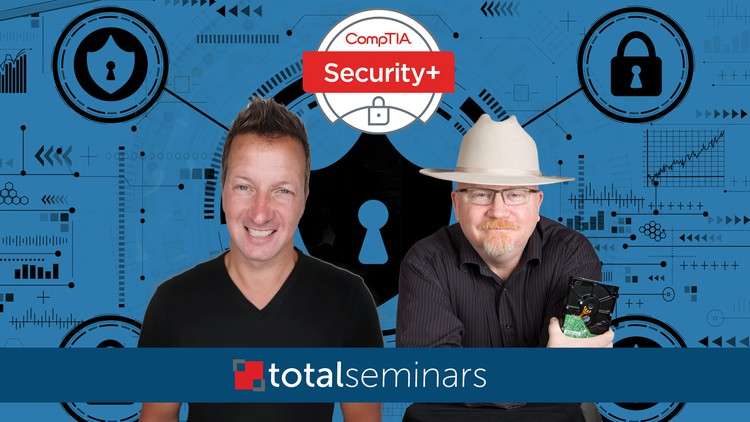
Everything you need to pass the CompTIA Security+ (SY0-601) exam from Mike Meyers and Dan Lachance
What you will learn
This is a complete and comprehensive CompTIA Security+ Certification (SY0-601) course. It is designed to prepare you to take and pass the CompTIA exam
You will have the knowledge and confidence to pass the CompTIA exam AND the skills to be a great IT security tech.
Your new skills and the CompTIA Security+ Cert will help you land a great IT security tech job or, get that raise or advancement you are after.
This course is ideal as both a study tool and an on-the-job reference for IT Security tasks.
Description
Welcome to the TOTAL: CompTIA Security+ Certification (SY0-601), a course from the production studios of Total Seminars with subject matter experts Mike Meyers and Dan Lachance.
This course covers everything you need to know to pass your CompTIA Security+ (SY0-601) certification exam. With over 17 hours of in-depth and fascinating content and 125 video lectures, this course will not only make you a good IT security tech, but make sure you are ready to pass the CompTIA Security+ exam. Mike Meyers is the President of Total Seminars and well known as the “Alpha Geek“. Mike is widely known at the #1 CompTIA author and instructor with over 1 million books in print. Dan Lachance is a highly motivated and passionate IT evangelist. He is a consultant, trainer, and author with over 20 years of experience in the IT security industry.
This course shows you how to:
- Apply the three “A’s” of security: authentication, authorization, and accounting
- Scan your wired or wireless network and assess it for various weaknesses
- Use cryptography to assure integrity of data through hashing and confidentiality of data through symmetric/asymmetric cryptosystems and public key infrastructure (PKI)
- Understand critical concepts in risk management, like setting up alerts, responding to incidents, and mitigating vulnerabilities
- Identify how hackers are trying to get into your network, IT infrastructure, and physical assets and how security techs help prevent those breaches
- Prevent attacks ranging from simple malware to sophisticated exploits to social engineering that takes advantage of people’s trust, relationships, and lack of knowledge
- Apply the techniques used in penetration testing, including passive and active reconnaissance
- Secure an enterprise environment, including creating incident response, business continuity, and disaster recovery plans
WHY SHOULD I TAKE THIS COURSE?
Total Seminars has an excellent reputation in the IT training industry, offering a wide variety of training tools. This course’s subject matter experts, Mike Meyers and Dan Lachance, have a combined 50+ years of experience. Mike has created training materials for thousands of schools, corporations, and government agencies, and has taught numerous seminars for the FBI, DEA, and many other corporate partners; he also wrote several bestselling CompTIA certification guides. Dan is the owner of Lachance IT Consulting, Inc. and has taught many online IT training courses in addition to his work as a network and server consultant and IT security auditor.
This course will also prepare you for the CompTIA Security+ exam, which is industry standard certification, compliant with ISO 17024 standards, accredited by ANSI, and approved by the U.S. Department of Defense.
The average beginner IT security salary is $74,000, and an information security analyst can make a much as is $117,000 starting out. If you’re looking to advance your career, this certification is a great place to start. 96% of HR managers use IT certifications as screening or hiring criteria during recruitment.
WHAT’S COVERED?
The course covers all the CompTIA Security+ (SY0-601) objective domains:
- Threats, Attacks, and Vulnerabilities (24%)
- Architecture and Design (21%)
- Implementation (25%)
- Operations and Incident Response (16%)
- Governance, Risk, and Compliance (14%)
EXAM INFO
- Exam code: SY0-601
- Max. 90 questions (performance-based and multiple choice)
- Length of exam: 90 minutes
- Passing score: 750 (on a scale of 100-900)
- Exam voucher cost: $349 USD (be sure to go to Total Seminars’ website for discount vouchers!)
- Recommended experience: CompTIA Network+ and two years of experience in IT administration with a security focus
- Testing provider: Pearson VUE (in-person and online at-home options available)
HOW DO I TAKE THE COMPTIA SECURITY+ EXAM?
Buy an exam voucher (get your discount voucher at Total Seminars’ website), schedule your exam on the Pearson VUE Web site, then take the exam at a qualifying Pearson VUE testing center or virtually using their OnVue option.
- Schedule through a testing center: pearsonvue. com
- Schedule an at-home (or at-work) exam: onvue. com
WHAT KIND OF JOB CAN I GET WITH A COMPTIA SECURITY+ CERTIFICATION?
- Security or systems administrator
- Security engineer/analyst
- Security IT auditor
- IT project manager
- Beginner cybersecurity specialist
- Junior IT auditor
- Junior penetration tester
Content